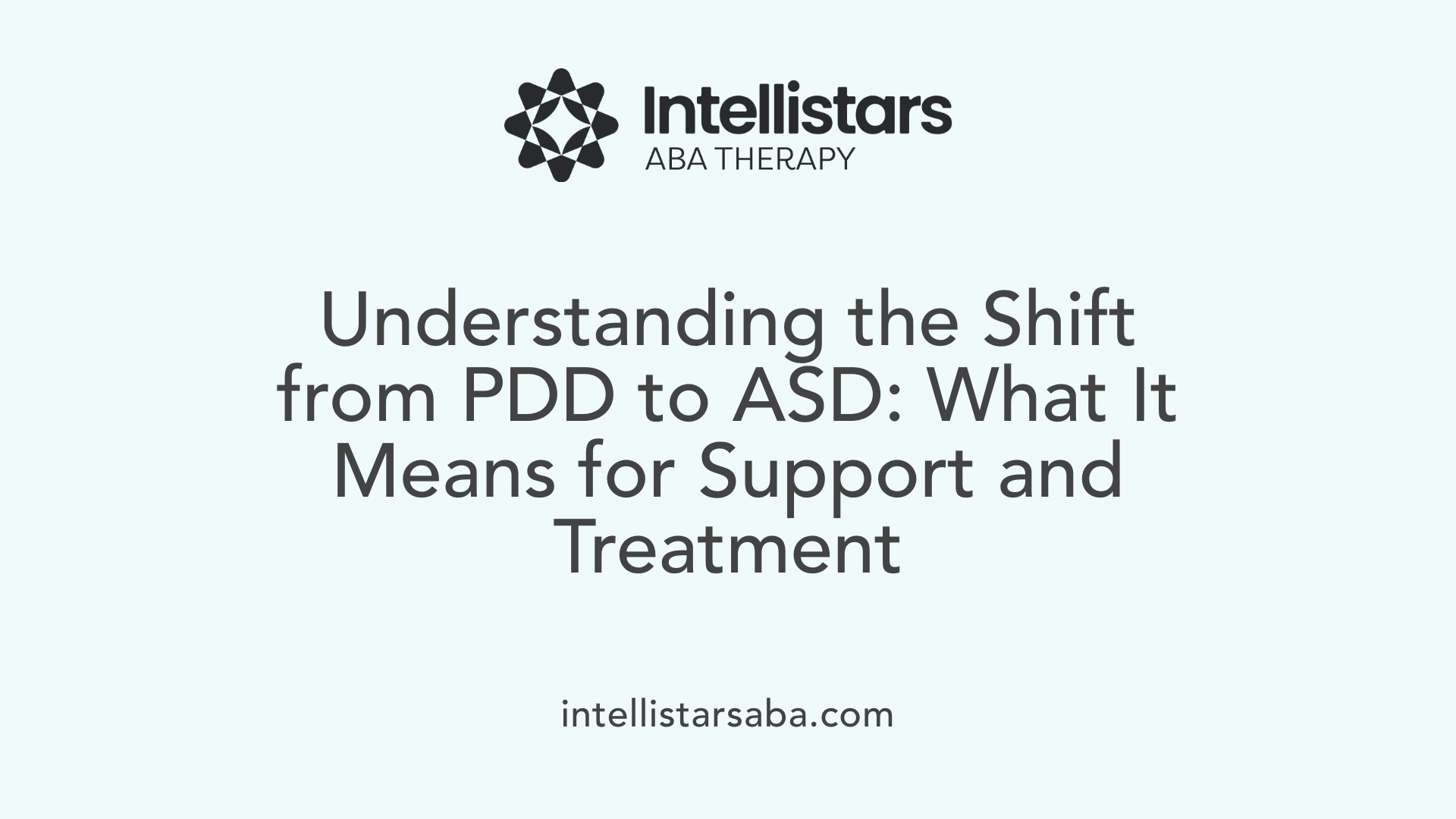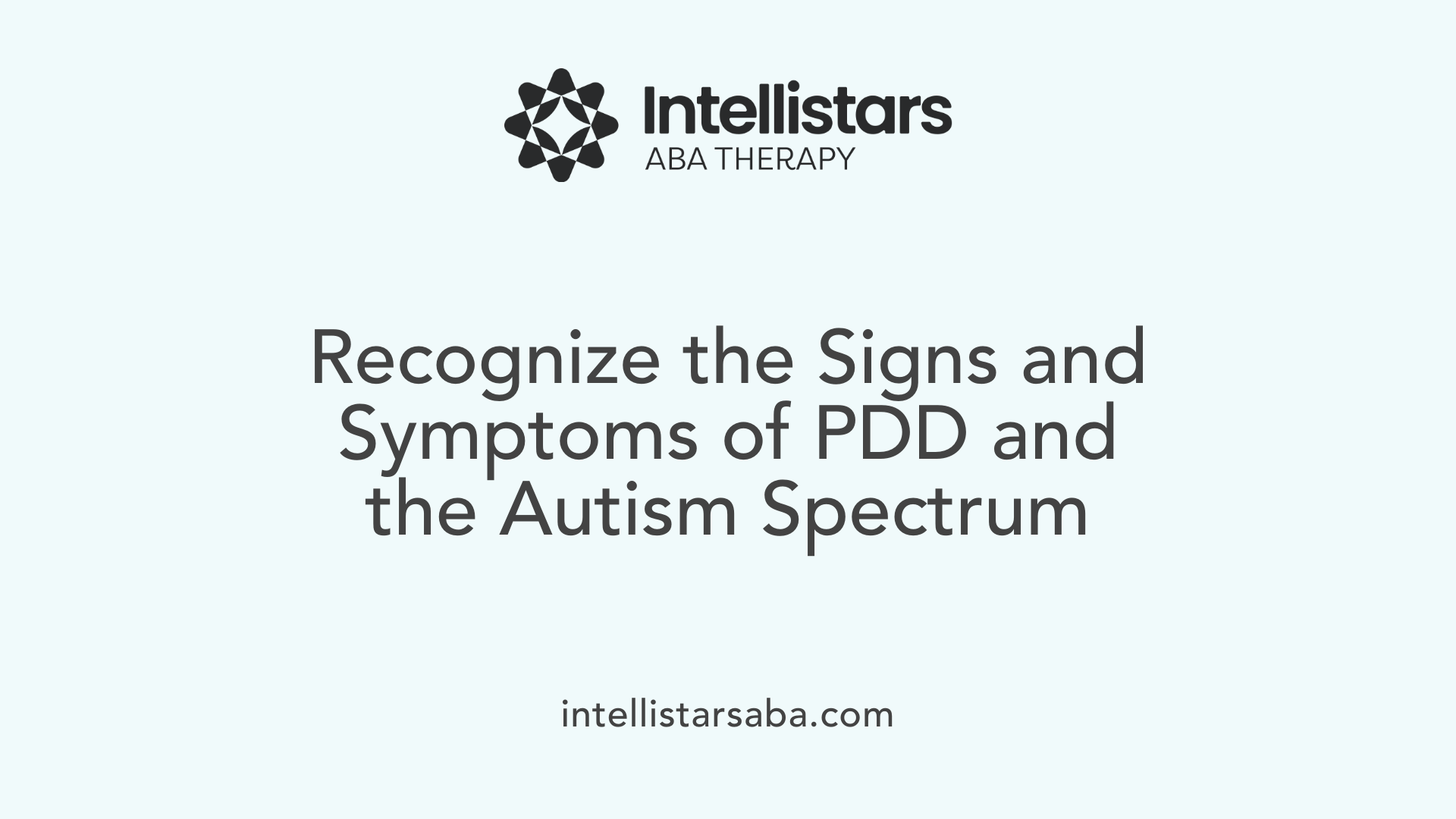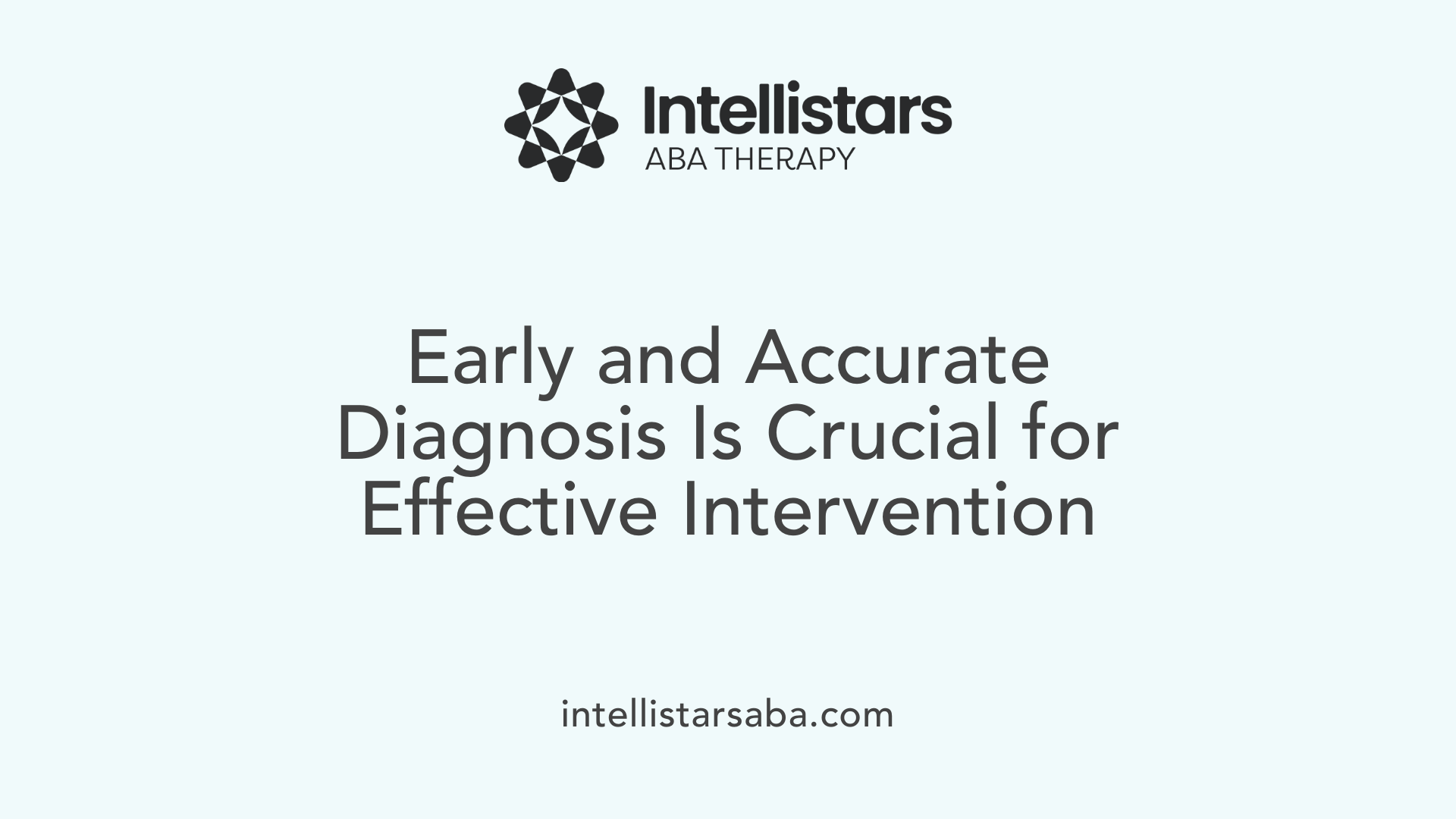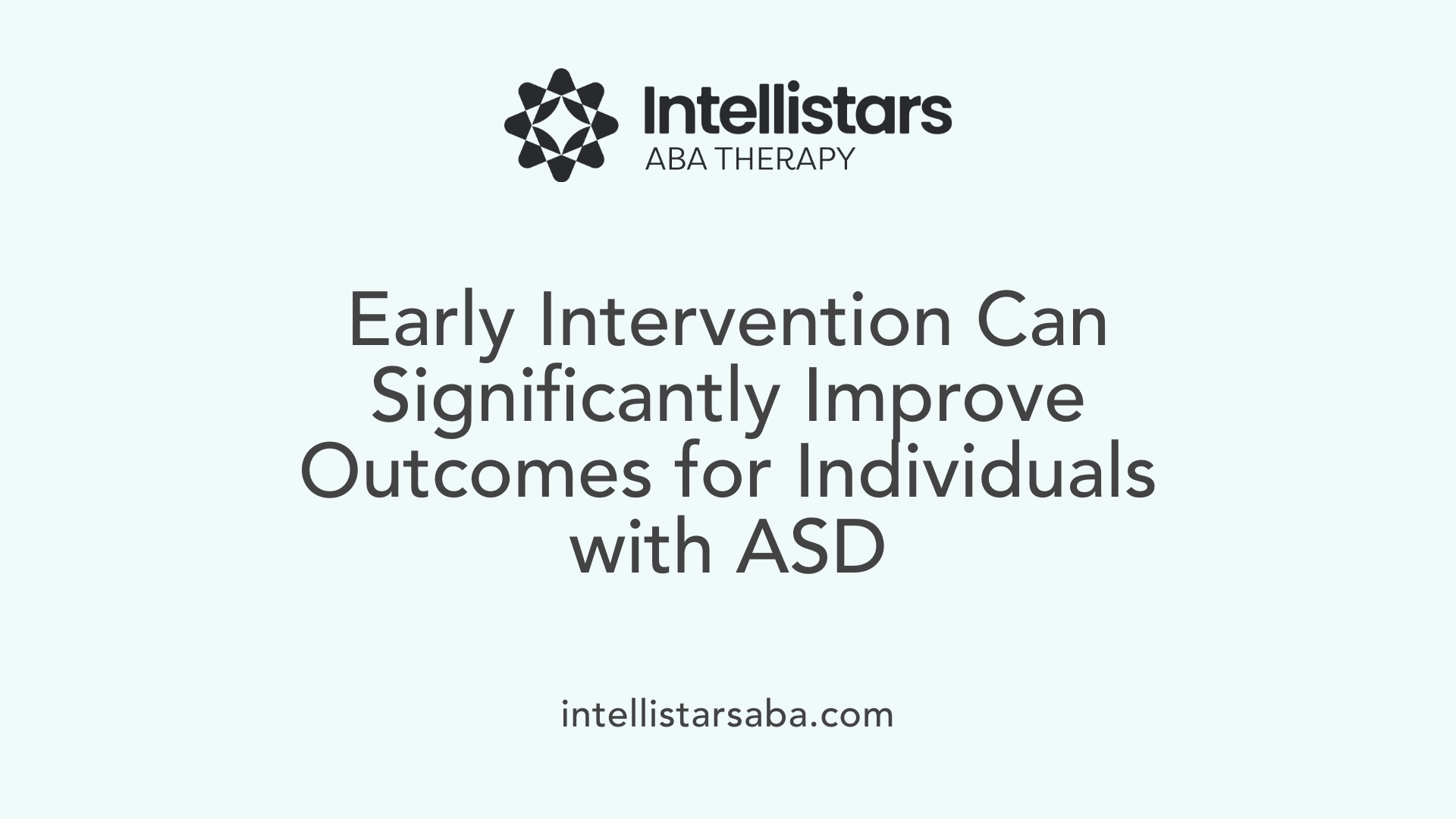Defining Pervasive Developmental Disorder
Pervasive Developmental Disorder (PDD) refers to a group of developmental conditions characterized by challenges in social interaction, communication, and repetitive behaviors. However, recent diagnostic shifts have reclassified PDD under the broader diagnosis of Autism Spectrum Disorder (ASD), reflecting a more nuanced understanding of these conditions. This article explores what PDD entailed, its relation to ASD, the causes, symptoms, and current therapeutic interventions such as Applied Behavior Analysis (ABA) therapy, aiming to offer clarity on this evolving topic.
From Pervasive Developmental Disorder to Autism Spectrum Disorder: Diagnostic Changes and Their Significance

Reclassification of Pervasive Developmental Disorder as Autism Spectrum Disorder
Pervasive Developmental Disorder (PDD) is no longer used as a diagnostic category. Instead, it has been fully absorbed into the broader diagnosis of Autism Spectrum Disorder (ASD). This change was implemented with the publication of the DSM-5, which sought to clarify and unify previous diagnostic terms.
Conditions Previously Classified Under PDD
Prior to this update, four distinct conditions were included under PDD: autistic disorder, Asperger’s syndrome, childhood disintegrative disorder, and PDD-Not Otherwise Specified (PDD-NOS). Each represented different manifestations on the autism spectrum, with variations in severity and symptomatology. For example, PDD-NOS was a diagnosis often given when an individual displayed some but not all traits of autism or had milder symptoms.
Implications of DSM-5 Changes for Diagnosis and Understanding
Moving to a single ASD diagnosis streamlines identification and treatment approaches. It acknowledges that autism-related symptoms exist along a continuum rather than as separate, discrete disorders. This harmonization helps clinicians tailor interventions more precisely based on severity and individual needs rather than strict categorical labels. Additionally, the change underscores the wide spectrum of autism, from individuals requiring significant support to those able to live independently. Importantly, this reclassification emphasizes early and accurate diagnosis, critical for accessing appropriate therapies and resources.
| Aspect | Previous Classification | DSM-5 Revision |
|---|---|---|
| Diagnostic Categories | Four distinct PDD conditions | Single category: Autism Spectrum Disorder |
| Focus | Separate diagnoses based on symptoms | Unified spectrum stressing severity and individualized needs |
| Clinical Impact | Potential confusion and overlap | Streamlined diagnosis and treatment planning |
| Public Understanding | Multiple autism-related terms | Simplified terminology improving clarity |
These changes reflect evolving scientific understanding and aim to provide better support for people across the autism spectrum.
Characteristics and Symptoms of Pervasive Developmental Disorder (PDD)

What are the core symptoms of Pervasive Developmental Disorder (PDD)?
Pervasive Developmental Disorder, now recognized as part of Autism Spectrum Disorder (ASD), primarily affects social interaction and communication. Individuals with PDD often face significant challenges in forming and maintaining social relationships. Communication delays are also common, including difficulties with language development and understanding nonverbal cues.
Repetitive behaviors and a strong resistance to changes in routine are hallmark features. These might include repetitive movements like hand flapping or rocking, intense attachments to specific routines, and challenges adapting to new situations.
What behavioral signs are commonly observed in individuals with PDD?
People with PDD typically avoid eye contact and may have trouble expressing their thoughts verbally, sometimes using high-pitched or flat voices. Emotional regulation problems are frequent, with individuals displaying difficulty managing feelings, which can lead to hyperactivity or self-injurious behaviors.
Stereotypic movements such as rocking or repetitive hand motions are often seen, alongside attachment to familiar objects or routines. These behaviors reflect the neurological differences in processing sensory and social information.
How does symptom severity vary across the spectrum?
ASD, including what was formerly diagnosed as PDD, encompasses a wide range of severity. Some individuals have mild symptoms, functioning independently with subtle social difficulties, while others experience severe challenges that impact daily living and require substantial support.
The spectrum nature means that symptoms and their intensity can vary greatly, influencing how each person is affected in social, communicative, and behavioral domains. Early diagnosis and tailored intervention play a crucial role in addressing individual needs effectively.
Genetic and Environmental Factors in the Causes of Pervasive Developmental Disorder and ASD
What role do genetics and gene mutations play in ASD?
Genetics significantly contribute to autism spectrum disorder, including conditions formerly known as pervasive developmental disorder (PDD). Research has identified mutations in over 100 different genes associated with ASD. These genetic changes can affect brain development and function, influencing the characteristic symptoms of ASD such as social and communication difficulties.
What environmental factors increase the risk for ASD?
Beyond genetics, environmental influences also play a notable role. Factors like prenatal infections, exposure to toxins during pregnancy, and complications during birth may increase ASD risk. Additionally, advanced parental age—especially for fathers—has been linked to a higher chance of having a child with ASD.
Are certain genetic disorders connected to a higher ASD risk?
Yes, some genetic conditions are linked to an increased likelihood of ASD. These include fragile X syndrome, Down syndrome, tuberous sclerosis, and Rett syndrome. Children with these disorders have a greater chance of displaying symptoms associated with ASD, emphasizing the complex interplay between genes and developmental outcomes.
Is there any link between vaccines and ASD?
Comprehensive studies have shown no connection between vaccines and autism spectrum disorder. This clarification is important to dispel myths and focus on scientifically supported causes and interventions.
In summary, ASD arises from both genetic mutations affecting numerous genes and environmental risk factors. The presence of associated genetic conditions further modifies risk, while misinformation—such as vaccine links—is unsupported by evidence.
Diagnosis and Screening of PDD and Autism Spectrum Disorder

How is PDD/ASD diagnosed without lab tests?
Diagnosing Pervasive Developmental Disorder (PDD), now classified within Autism Spectrum Disorder (ASD), relies primarily on thorough behavioral observations and detailed developmental histories. Unlike many medical conditions, there are no laboratory tests or biomarkers for PDD/ASD. Instead, clinicians employ a combination of clinical interviews, standardized assessments, and parent reports to form a comprehensive view of an individual’s developmental progress and behavioral patterns.
What tools are used in assessing PDD/ASD?
Clinical evaluation includes structured interviews with caregivers and individuals, direct observation of social communication skills, and standardized tools designed to assess language use, social interaction, and repetitive behaviors. These assessments help differentiate ASD from other developmental disorders and identify severity and support needs.
Why is screening recommended at 18-24 months?
Pediatricians routinely screen children for ASD signs during checkups between 18 and 24 months of age. Early screening is critical because symptoms can be subtle in infancy but emerge more clearly around age three, allowing prompt referral for further evaluation and intervention. Early detection increases the chances of benefiting from therapies that support communication, social skills, and behavioral management.
How does early diagnosis benefit children with PDD/ASD?
Identifying ASD early not only aids families and healthcare providers in understanding the child's needs but also facilitates timely access to supportive and behavioral therapies. Early intervention has been shown to improve long-term outcomes, including greater success in education and enhanced independence in adult life. Therefore, prompt and accurate diagnosis is foundational to helping individuals on the spectrum reach their full potential.
An In-Depth Look at Applied Behavior Analysis (ABA) Therapy
What is Applied Behavior Analysis (ABA) therapy?
Applied Behavior Analysis (ABA) therapy is a scientifically validated method aimed at understanding and modifying behavior. It is widely used to support individuals with autism spectrum disorder (ASD). ABA therapy focuses on increasing beneficial behaviors such as communication, social skills, and daily living capabilities while decreasing harmful or disruptive behaviors.
The therapy uses techniques like positive reinforcement, where desirable behaviors are rewarded to encourage their recurrence. Behavioral assessments help professionals identify specific behaviors to target and track progress. Programs are highly individualized, tailored to meet each person's unique developmental needs.
ABA can take place in varied environments, including the home, school, or community settings. Regular evaluation and adaptation of the treatment plan by specialists ensure the therapy remains effective over time. Research indicates that intensive ABA therapy, started early and continued consistently over years, significantly improves developmental outcomes.
Who typically provides ABA therapy services?
ABA therapy is delivered by a team of trained professionals, including Board-Certified Behavior Analysts (BCBAs), Associate Behavior Analysts (BCaBAs), and Registered Behavior Technicians (RBTs). The BCBAs lead the process by conducting behavioral assessments, designing personalized treatment plans, and supervising therapy implementation.
BCaBAs may assist with supervision and direct therapy, while RBTs and paraprofessionals carry out daily therapy sessions under their guidance. These experts work across different settings—homes, schools, and community centers—to deliver consistent and comprehensive interventions.
Their combined efforts focus on improving behavior, communication, and social skills for individuals with ASD, making ABA therapy a cornerstone in developmental support.
Benefits, Goals, and Delivery Methods of ABA Therapy for Autism Spectrum Disorder
How does ABA therapy benefit individuals with autism?
ABA therapy plays a significant role in helping individuals with autism spectrum disorder develop essential life skills. It improves communication abilities, enhances social interaction, and promotes daily living skills. Additionally, it helps reduce problematic behaviors that might interfere with learning and socialization.
This therapy uses evidence-based methods grounded in science, including positive reinforcement, prompting, and careful analysis of environmental influences. By tailoring intervention strategies to each individual's unique needs, ABA encourages helpful behaviors while discouraging harmful ones. Early and intensive ABA therapy, sometimes involving over 20 hours per week, can lead to notable developmental improvements, enabling many children to participate more effectively in mainstream settings. This approach fosters greater independence and improves overall quality of life.
What are the main goals of ABA therapy?
The primary objectives of ABA therapy focus on enhancing core skills necessary for independent living and success. These include improving communication—both verbal and nonverbal—strengthening social skills like sharing and turn-taking, and developing self-help abilities such as dressing and hygiene.
ABA also targets the reduction of problematic behaviors including aggression and self-injury by teaching positive, functional alternatives. Goals are highly individualized and often broken down into manageable steps to build mastery and confidence. Overall, ABA aims to improve quality of life and support individuals with autism in reaching their full potential across all aspects of daily living.
How is ABA therapy typically delivered?
ABA therapy is generally provided through individualized, structured sessions. These might involve one-on-one work with a trained therapist or, in some cases, small group settings depending on personal needs.
Techniques used in delivery include discrete trial training (DTT), modeling desired behaviors, and visual communication tools such as the Picture Exchange Communication System (PECS). Therapists rely on positive reinforcement, prompts, and consistent data collection to track progress and adjust interventions.
ABA is very adaptable and can be carried out across multiple environments including at home, at school, or in community settings. This flexibility allows the therapy to be customized for each person’s specific goals and everyday life situations, maximizing its effectiveness.
Challenges and Criticisms Surrounding ABA Therapy
Are there any challenges or criticisms associated with ABA therapy?
Applied Behavior Analysis (ABA) is a widely used therapy for autism spectrum disorder (ASD), but it faces several challenges and criticisms. One common concern is that the repetitive nature of ABA may lead to emotional distress or burnout in some individuals undergoing treatment. Critics argue that the therapy can focus heavily on compliance and behavior control, which might overshadow the child's emotional well-being.
Historically, some ABA programs included coercive or aversive techniques—methods now broadly rejected due to ethical issues. These past practices have contributed to mistrust and criticism from many in the autism community.
A significant point of debate revolves around the neurodiversity movement. Autism advocates stress the importance of accepting autistic behaviors as part of an individual's identity rather than aiming to make them conform to neurotypical standards. They worry that some ABA approaches seek to 'normalize' behaviors, potentially suppressing natural traits and causing harm.
Modern ABA therapy, however, increasingly focuses on individualized and respectful treatment plans. These approaches prioritize the needs, preferences, and dignity of each person. The ongoing dialogue about ABA highlights the critical need for interventions that both improve functioning and honor the autonomy and identity of neurodiverse individuals.
Supportive Therapies and Management Strategies Beyond ABA
Other therapies such as speech, occupational, physical, music, art, and family therapy
Supportive therapies play a vital role in managing autism spectrum disorder (ASD), including individuals formerly diagnosed with Pervasive Developmental Disorder (PDD). Speech therapy helps improve communication skills, addressing language delays and enhancing the ability to express thoughts. Occupational therapy targets everyday living skills and sensory processing challenges, while physical therapy assists with motor skills and coordination. Additionally, music and art therapies offer creative outlets for emotional expression and social engagement. Family therapy supports caregivers and strengthens family dynamics, essential for holistic care.
Role of medications in managing associated conditions like anxiety and ADHD
No medications specifically treat the core symptoms of ASD, but pharmacological treatments are often used to manage co-occurring conditions such as anxiety, depression, and attention-deficit/hyperactivity disorder (ADHD). Approved medications like risperidone and aripiprazole can be prescribed to address irritability and behavioral issues in individuals with ASD. Medication, combined with behavioral and supportive therapies, can significantly improve quality of life.
Complementary therapies including yoga, massage
Complementary approaches like yoga and massage therapy are becoming increasingly popular as adjuncts to conventional treatments. These therapies may help with relaxation, emotional regulation, and reducing hyperactivity. While they do not replace core therapies, they can enhance overall well-being and support emotional and physical health.
Importance of early intervention and individualized treatment plans
Early diagnosis and intervention are crucial for optimizing outcomes in ASD. Treatment plans must be highly individualized, taking into account specific developmental assessments and unique needs. Combining various therapies tailored to the individual promotes better social, communicative, and behavioral progress. Early and customized support substantially increases the chances of success in education and eventual independence.
Outlook and Importance of Early Intervention in PDD and ASD

How Severe Can ASD Be Across Its Spectrum?
ASD, including what was formerly termed PDD-NOS, encompasses a wide spectrum of severity. Some individuals live independently, hold jobs, and manage daily life effectively. Others face significant challenges, requiring lifelong support due to severe disabilities. This broad range underscores the need for personalized approaches in care and therapy.
What Are the Benefits of Early Diagnosis and Intervention?
Early diagnosis—often around age 3 but sometimes noticed in infancy—allows timely access to essential therapies. Early interventions, such as applied behavioral analysis (ABA), speech therapy, and occupational therapy, focus on developing communication and social skills while managing behaviors. These interventions have been shown to improve long-term outcomes, enhancing educational success and increasing the likelihood of independent living.
What Complications Can Arise If PDD/ASD Goes Untreated?
Without appropriate intervention, individuals with PDD or ASD may experience difficulties such as anxiety, depression, disruptive behaviors, and problems in school or work settings. Such complications can hinder social integration and reduce the quality of life. Early and ongoing support aims to minimize these risks by addressing symptoms proactively.
How Do Interventions Improve Quality of Life and Independence?
The overarching goal of early and sustained intervention is to improve functional abilities and promote independence. Therapies are tailored to individual needs, focusing on communication, emotional regulation, and behavioral management. Encouragingly, these approaches have helped many with ASD lead fulfilling, autonomous lives.
| Aspect | Details | Impact on Individual |
|---|---|---|
| Spectrum Severity | Ranges from mild (high-functioning) to severe disabilities | Determines level of support required |
| Early Intervention | ABA, speech, occupational, physical therapies started early | Improves developmental trajectories |
| Possible Complications | Anxiety, depression, disruptive behavior, educational/employment challenges | Can be mitigated or reduced with effective treatment |
| Goals of Treatment | Enhance communication, social skills, emotional control, independent functioning | Better quality of life and autonomy |
Looking Ahead: Moving Beyond the Label of Pervasive Developmental Disorder
Pervasive Developmental Disorder, once a distinct diagnostic category, is now understood within the broader framework of Autism Spectrum Disorder, reflecting the complexity and diversity of these developmental conditions. Understanding this evolution is crucial for appreciating the spectrum of symptoms and the importance of personalized interventions. Applied Behavior Analysis (ABA) therapy remains a cornerstone treatment, offering scientifically supported methods to develop vital skills and improve quality of life, despite facing some criticism. Comprehensive management also includes various supportive therapies and medical care tailored to individual needs. Ultimately, early diagnosis and intervention are essential to unlocking the fullest potential of individuals affected by ASD, moving beyond labels to embrace a future of greater understanding, support, and inclusion.
References
- Pervasive Developmental Disorder (PDD)
- pdd, pervasive developmental disorder, pdd-nos ...
- Pervasive Developmental Disorders (PDD)
- Pervasive Developmental Disorder: Definition, Symptoms ...
- ABA Therapy Examples, Definition & Techniques
- Applied Behavior Analysis (ABA)
- How to Become an Applied Behavior Analyst (ABA) Therapist
- How to Become an ABA Therapist - School of Education
- Applied Behavior Analysis (ABA)
- Applied Behavior Analysis (ABA)






